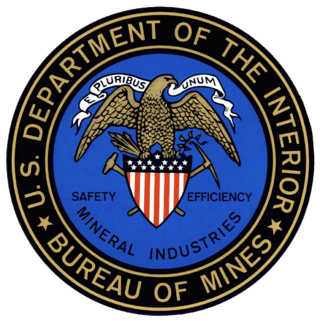Related Research Articles
Coal dust is a fine-powdered form of coal which is created by the crushing, grinding, or pulverization of coal rock. Because of the brittle nature of coal, coal dust can be created by mining, transporting, or mechanically handling it.

Mining in the engineering discipline is the extraction of minerals from the ground. Mining engineering is associated with many other disciplines, such as mineral processing, exploration, excavation, geology, metallurgy, geotechnical engineering and surveying. A mining engineer may manage any phase of mining operations, from exploration and discovery of the mineral resources, through feasibility study, mine design, development of plans, production and operations to mine closure.
A mining accident is an accident that occurs during the process of mining minerals or metals. Thousands of miners die from mining accidents each year, especially from underground coal mining, although accidents also occur in hard rock mining. Coal mining is considered much more hazardous than hard rock mining due to flat-lying rock strata, generally incompetent rock, the presence of methane gas, and coal dust. Most of the deaths these days occur in developing countries, and rural parts of developed countries where safety measures are not practiced as fully. A mining disaster is an incident where there are five or more fatalities.

For most of the 20th century, the United States Bureau of Mines (USBM) was the primary United States government agency conducting scientific research and disseminating information on the extraction, processing, use, and conservation of mineral resources. The Bureau was abolished in 1996.

The Mine Safety and Health Administration (MSHA) is a large agency of the United States Department of Labor which administers the provisions of the Federal Mine Safety and Health Act of 1977 to enforce compliance with mandatory safety and health standards as a means to eliminate fatal accidents, to reduce the frequency and severity of nonfatal accidents, to minimize health hazards, and to promote improved safety and health conditions in the nation's mines. MSHA carries out the mandates of the Mine Act at all mining and mineral processing operations in the United States, regardless of size, number of employees, commodity mined, or method of extraction. David Zatezalo was sworn in as Assistant Secretary of Labor for Mine Safety and Health, and head of MSHA, on November 30, 2017. He served until January 20, 2021. Jeannette Galanais served as Acting Assistant Secretary by President Joe Biden on February 1, 2021 until Christopher Williamson took office on April 11, 2022.

Massey Energy Company was a coal extractor in the United States with substantial operations in West Virginia, Kentucky and Virginia. By revenue, it was the fourth largest producer of coal in the United States and the largest coal producer in Central Appalachia. By coal production weight, it was the sixth largest producer of coal in the United States.

Black lung disease (BLD), also known as coal workers' pneumoconiosis, or simply black lung, is an occupational type of pneumoconiosis caused by long-term inhalation and deposition of coal dust in the lungs and the consequent lung tissue's reaction to its presence. It is common in coal miners and others who work with coal. It is similar to both silicosis from inhaling silica dust and asbestosis from inhaling asbestos dust. Inhaled coal dust progressively builds up in the lungs and leads to inflammation, fibrosis, and in worse cases, necrosis.

The Federal Coal Mine Health and Safety Act of 1969, U.S. Public Law 91-173, generally referred to as the Coal Act, was passed by the 91st United States Congressional session and enacted into law by the 37th President of the United States Richard Nixon on December 30, 1969.

The Sago Mine disaster was a coal mine explosion on January 2, 2006, at the Sago Mine in Sago, West Virginia, United States, near the Upshur County seat of Buckhannon. The blast and collapse trapped 13 miners for nearly two days; only one survived. It was the worst mining disaster in the United States since the Jim Walter Resources Mine disaster in Alabama on September 23, 2001, and the worst disaster in West Virginia since the 1968 Farmington Mine disaster. It was exceeded four years later by the Upper Big Branch Mine disaster, also a coal mine explosion in West Virginia, which killed 29 miners in April 2010.
The Safety and Health in Mines Convention, 1995 is an International Labor Organization Convention adopted at the 82nd International Labor Conference (ILC). The convention (C176) was developed and adopted to better recognize the inherent hazards of the mining workplace and the necessity of addressing these hazards on a global scale.

The health and environmental impact of the coal industry includes issues such as land use, waste management, water and air pollution, caused by the coal mining, processing and the use of its products. In addition to atmospheric pollution, coal burning produces hundreds of millions of tons of solid waste products annually, including fly ash, bottom ash, and flue-gas desulfurization sludge, that contain mercury, uranium, thorium, arsenic, and other heavy metals. Coal is the largest contributor to the human-made increase of carbon dioxide in Earth's atmosphere.

The Upper Big Branch Mine disaster occurred on April 5, 2010, roughly 1,000 feet (300 m) underground in Raleigh County, West Virginia at Massey Energy's Upper Big Branch coal mine located in Montcoal. 29 out of 31 at the site were killed. The coal dust explosion occurred at 3:27 pm. The incident was the worst in the United States since 1970, when 38 miners were killed at Finley Coal Company's No. 15 and 16 mines in Hyden, Kentucky. A state funded independent investigation later found Massey Energy directly responsible for the blast.

Mine safety is a broad term referring to the practice of controlling and managing a wide range of hazards associated with the life cycle of mining-related activities. Mine safety practice involves the implementation of recognised hazard controls and/or reduction of risks associated with mining activities to legally, socially and morally acceptable levels. While the fundamental principle of mine safety is to remove health and safety risks to mine workers, mining safety practice may also focus on the reduction of risks to plant (machinery) together with the structure and orebody of the mine.

The Federal Coal Mine Safety Act of 1952 is a U.S. law authorizing the federal government to conduct annual inspections of underground coal mines with more than 15 workers, and gave the United States Bureau of Mines the authority to shut down a mine in cases of "imminent danger." The Act authorized the assessment of civil penalties against mine operators for failing to comply with an order to shut down or for refusing to give inspectors access to mine property. The law did not authorize monetary penalties for noncompliance with the safety provisions. In 1966, Congress extended coverage to all underground coal mines.
Occupational epidemiology is a subdiscipline of epidemiology that focuses on investigations of workers and the workplace. Occupational epidemiologic studies examine health outcomes among workers, and their potential association with conditions in the workplace including noise, chemicals, heat, or radiation, or work organization such as schedules.

Occupational dust exposure occurs when small particles are generated at the workplace through the disturbance/agitation of rock/mineral, dry grain, timber, fiber, or other material. When these small particles become suspended in the air, they can pose a risk to the health of those who breath in the contaminated air.
A tapered element oscillating microbalance (TEOM) is an instrument used for real-time detection of aerosol particles by measuring their mass concentration. It makes use of a small vibrating glass tube whose oscillation frequency changes when aerosol particles are deposited on it increasing its inertia. TEOM-based devices have been approved by the U.S. Environmental Protection Agency for environmental air quality monitoring, and by the U.S. Mine Safety and Health Administration for monitoring coal dust exposure for miners to prevent several respiratory diseases.
J. Davitt McAteer is an American lawyer, author, and activist from Fairmont, West Virginia. McAteer was appointed to the position of assistant secretary for the Mine Safety and Health Administration from 1993 to 2000 under President Bill Clinton. Throughout his career, McAteer has been an advocate for safe working conditions for miners, particularly in the coal industry. After the Upper Big Branch Mine disaster of 2010, where an explosion caused by negligence led to the death of 29 miners, McAteer Served on Governor Earl Ray Tomblin's independent investigation panel to determine the cause of the explosion. McAteer is the author of "Monongah: The Tragic Story of the 1907 Monongah Mine Disaster".

Federal Mines Safety Act of 1910 was a United States statute passed for the purposes of establishing the United States Bureau of Mines as a federal agency of the United States Department of the Interior. The Act of Congress authorized investigations of mining methods with an emphasis regarding the safety of miners while recovering combustible fossil fuels and confronting occupational dust exposure.

The Scotia Mine was a coal mine that operated in the community of Oven Fork in Letcher County, Kentucky. The mine began operations in 1962, as a subsidiary of the Blue Diamond Coal Company. In March 1976, two explosions occurred within the mine, killing 26 miners. The explosions led to the passage of several acts relating to safety in coal mines.
References
- ↑ Harteis, SP; Alexander, DW; Harris, ML; Sapko, M; Weiss, ES (1 November 2016). "Review of Rock Dusting Practices in Underground Coal Mines". U.S. National Institute for Occupational Safety and Health. Retrieved 11 March 2019.
- ↑ Harris, Marcia L.; Sapko, Michael J.; Varley, Floyd D.; Weiss, Eric S. (August 2012). "Coal Dust Explosibility Meter Evaluation and Recommendations for Application" (PDF). Centers for Disease Control. Retrieved 30 March 2019.
 This article incorporates text from this source, which is in the public domain .
This article incorporates text from this source, which is in the public domain .